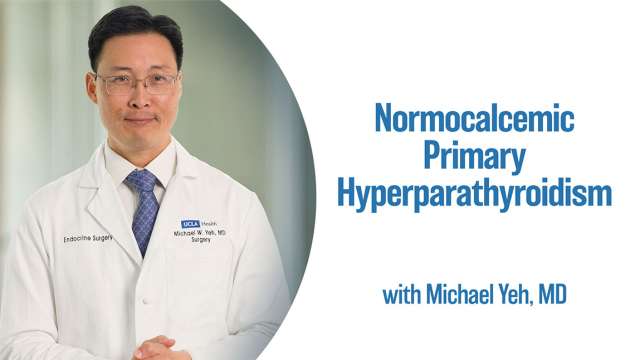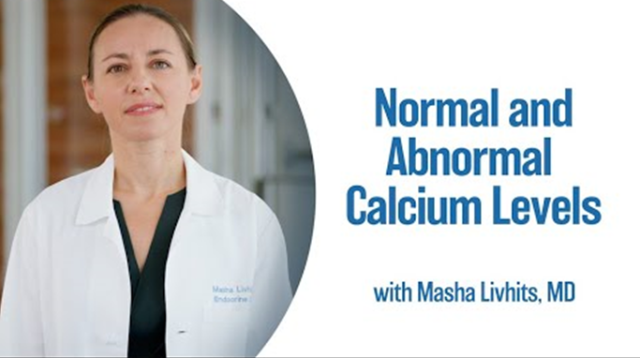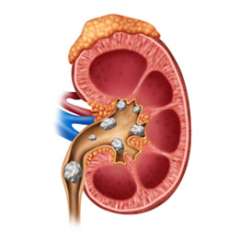Normocalcemic Primary Hyperparathyroidism
Find your care
We deliver effective, minimally invasive treatments in a caring environment. Call 310-267-7838 to connect with an expert in endocrine surgery.
What is normocalcemic primary hyperparathryoidism (nPHPT)?
Normocalcemic primary hyperparathyroidism (nPHPT) is suspected when patients’ calcium level is within the normal range, but parathyroid hormone level is too high. (See Normal Calcium Levels) This condition is not well understood in the medical literature. This is simply because normal individuals do not have their parathyroid hormone levels checked. UCLA Health offers expert diagnosis and selective surgical treatment for nPHPT.

Michael Yeh here from UCLA here to talk about normocalcemic primary hyperparathyroidism. This is a condition where the blood calcium level remains normal—typically between 8.5 and 10.3 mg/dL—while the parathyroid hormone (PTH) level is elevated, usually 65 pg/mL or greater.
Hi, I'm Dr. Masha Livhits, an endocrine surgeon at UCLA. A common reason that patients come to see us at the UCLA Health Endocrine Center is a high calcium level on a blood test. Our job is to help figure out why the calcium level is high and what we can do to correct it.

Normocalcemic primary hyperparathyroidism (nPHPT) is hypothesized to be an “early” type of primary hyperparathyroidism. Primary hyperparathyroidism is when one or more of the parathyroid glands makes too much parathyroid hormone, which draws calcium from the bones into the blood, weakening bone density and raising blood calcium level. In normocalcemic PHPT, the parathyroid glands are releasing too much hormone, but the blood calcium level has not risen yet.
Primary hyperparathyroidism is typically diagnosed when patients are found to have high blood calcium during routine checkups. However, nPHPT cannot be detected through high blood calcium lab results, because these patients have normal calcium levels. Patients with nPHPT are often uncovered during work up for osteoporosis or low bone mineral density.
Proper diagnosis of normocalcemic primary hyperparathyroidism is challenging, because there are several other causes of high parathyroid hormone levels and normal calcium levels. Because several other conditions may mimic normocalcemic primary hyperparathyroidism, detailed blood and sometimes urine testing is required to establish the definitive diagnosis.
Does normocalcemic primary hyperparathyroidism cause bone problems such as osteopenia or osteoporosis?
Nearly half of patients diagnosed with normocalcemic primary hyperparathyroidism have been found to have osteoporosis. However, parathyroid hormone is more frequently performed in patients with osteopenia or osteoporosis. For this reason, it is possible these diagnoses are found together by coincidence. Therefore, normocalcemic primary hyperparathyroidism may cause bone loss.
Does normocalcemic primary hyperparathyroidism cause kidney stones?
The short answer is that we do not know for sure. We do know that primary hyperparathyroidism with high calcium levels does cause kidney stones. Current research tells us that 4-35% of patients normocalcemic primary hyperparathyroidism have kidney stones. However, since ~8% of people in the population have kidney stones for other reasons, it is unclear if nPHPT increases that risk even further.
What other conditions aside can cause high parathyroid hormone levels?
To diagnose normocalcemic primary hyperparathyroidism, other conditions that may cause high parathyroid hormone levels need to be ruled out. Here are other common causes of high parathyroid hormone levels:
- Secondary hyperparathyroidism
- Vitamin D deficiency
- Not enough calcium in diet
- Intestinal problems causing poor absorption of calcium
- Kidney failure or kidney problems
- Certain medications
- Loop diuretics, such as Lasix aka furosemide
- Lithium
- Bisphosphonates
- Denosumab
- Anti-seizure medications
What is secondary hyperparathyroidism?
To diagnose nPHPT, we must rule out secondary hyperparathyroidism. Secondary hyperparathyroidism is different from primary hyperparathyroidism. In primary hyperparathyroidism, the parathyroid tissue is abnormal and making too much parathyroid hormone. In secondary hyperparathyroidism, the parathyroid gland is functioning normally and is only producing high levels of parathyroid hormone because the body is signaling that it needs more calcium in the blood.
One major cause of secondary hyperparathyroidism is vitamin D deficiency. Vitamin D is required for the body to absorb calcium from food. The normal range of Vitamin D is 30-80 ng/mL. With low levels of vitamin D, patients are not able to absorb calcium correctly and therefore the blood calcium is low. The parathyroid glands compensate by increasing PTH levels to increase blood calcium. Patients with normal levels of calcium, high levels of PTH, and vitamin D deficiency could have secondary hyperparathyroidism. Patients with low levels of calcium and high levels of PTH have secondary hyperparathyroidism.
After vitamin D supplementation, the patient’s PTH level should return to normal. If calcium levels become high and PTH remains high after Vitamin D supplementation, this establishes the diagnosis of primary hyperparathyroidism.

Another possible cause of secondary hyperparathyroidism is not eating enough calcium or the intestines not absorbing calcium. Both of these could also cause low body calcium, prompting the parathyroid glands to make extra parathyroid hormone. Intestinal problems such as celiac disease and previous weight loss surgeries could cause absorption problems.
Ruling out Chronic Kidney Disease and Urinary Calcium Leaks
Kidney failure, or an eGFR of less than 60, causes a problem with vitamin D metabolism. This also leads to the parathyroid glands appropriately compensating the loss of blood calcium by increasing PTH levels. Calcium in the blood can also be lost as blood filters through the kidneys and too much calcium leaks into the urine (called urinary calcium leak). Excess calcium in kidney filtration can lead to kidney stones.
| Measure | Primary Hyperparathyroidism | Normocalcemic Primary Hyperparathyroidism (nPHPT) | Secondary Hyperparathyroidism |
|---|---|---|---|
| Blood Calcium | High | Normal | Normal or low |
| Parathyroid Hormone | High | High | High |
| Vitamin D | Usually normal | Must be normal | May be low |
| GFR (kidney function) | Usually normal | Must be normal | May be low |
What is the treatment for normocalcemic primary hyperparathyroidism?
Not everyone with normocalcemic primary hyperparathyroidism needs treatment. Many patients can be safely monitored over time. About 15% of people seem to progress to primary hyperparathyroidism and develop high blood calcium levels; these patients ultimately need surgery.
Our practice is to offer surgery selectively to patients with normocalcemic primary hyperparathyroidism. Currently, less than 1/3 of our patients with nPHPT undergo surgery. The typical patient who undergoes surgery at our center for nPHPT is selected for parathyroid surgery because they have progressive unexplained bone loss. After successful surgery, bone mineral density improves in approximately half of patients with nPHPT. At present there is no compelling evidence that non-specific symptoms (i.e. fatigue, lethargy, depression, forgetfulness, vague abdominal pain, loss of appetite) improve after parathyroid surgery for nPHPT.
Bone loss related to nPHPT may also be treated with medications used to treat osteopenia and osteoporosis. The combination of vitamin D and a type of medication called bisphosphonates can be used to improve bone health in patients with normocalcemic primary hyperparathyroidism. Other treatments for severe osteoporosis include injections that prevent breakdown of bone by bone cells (denosumab) and promoting bone formation (romosozumab). For patients with kidney stones, there is very limited evidence that cinacalcet may help reduce the size and number of kidney stones.
Got Questions About Normal and High Calcium Levels? Please Contact Us.
Find your care
We deliver effective, minimally invasive treatments in a caring environment.
Call 310-267-7838 to connect with an expert in endocrine surgery.
-
- Yeh MW, Ituarte PH, Zhou HC, et al. Incidence and prevalence of primary hyperparathyroidism in a racially mixed population. The Journal of clinical endocrinology and metabolism. 2013;98(3):1122-1129.
- Cusano NE, Maalouf NM, Wang PY, et al. Normocalcemic hyperparathyroidism and hypoparathyroidism in two community-based nonreferral populations. The Journal of clinical endocrinology and metabolism. 2013;98(7):2734-2741.
- Garcia-Martin A, Reyes-Garcia R, Munoz-Torres M. Normocalcemic primary hyperparathyroidism: one-year follow-up in one hundred postmenopausal women. Endocrine. 2012;42(3):764-766.
- Lundgren E, Rastad J, Thrufjell E, Akerström G, Ljunghall S. Population-based screening for primary hyperparathyroidism with serum calcium and parathyroid hormone values in menopausal women. Surgery. 1997;121(3):287-294.
- Rosário PW, Calsolari MR. Normocalcemic Primary Hyperparathyroidism in Adults Without a History of Nephrolithiasis or Fractures: A Prospective Study. hmr. 2019;51(04):243-247.
- Maruani Gr, Hertig A, Paillard M, Houillier P. Normocalcemic Primary Hyperparathyroidism: Evidence for a Generalized Target-Tissue Resistance to Parathyroid Hormone. The Journal of Clinical Endocrinology & Metabolism. 2003;88(10):4641-4648.
- Marques TF, Vasconcelos R, Diniz E, Rego D, Griz L, Bandeira F. Normocalcemic primary hyperparathyroidism in clinical practice: an indolent condition or a silent threat? Arquivos brasileiros de endocrinologia e metabologia. 2011;55(5):314-317.
- Schini M, Jacques RM, Oakes E, Peel NFA, Walsh JS, Eastell R. Normocalcemic Hyperparathyroidism: Study of its Prevalence and Natural History. The Journal of clinical endocrinology and metabolism. 2020;105(4):e1171-1186.
- Babwah F, Buch HN. Normocalcaemic primary hyperparathyroidism: a pragmatic approach. Journal of Clinical Pathology. 2018;71(4):291-297.
- Cusano NE, Cipriani C, Bilezikian JP. Management of normocalcemic primary hyperparathyroidism. Best practice & research Clinical endocrinology & metabolism. 2018;32(6):837-845.
- Pawlowska M, Cusano NE. An overview of normocalcemic primary hyperparathyroidism. Current opinion in endocrinology, diabetes, and obesity. 2015;22(6):413-421.
- Šiprová H, Fryšák Z, Soucek M. Primary Hyperparathyroidism, With A Focus On Management Of The Normocalcemic Form: To Treat Or Not To Treat? Endocrine Practice. 2016;22(3):294-301.
- Lowe H, McMahon DJ, Rubin MR, Bilezikian JP, Silverberg SJ. Normocalcemic Primary Hyperparathyroidism: Further Characterization of a New Clinical Phenotype. The Journal of Clinical Endocrinology & Metabolism. 2007;92(8):3001-3005.
- Silverberg SJ, Bilezikian JP. “Incipient” Primary Hyperparathyroidism: A “Forme Fruste” of an Old Disease. The Journal of Clinical Endocrinology & Metabolism. 2003;88(11):5348-5352.
- Eastell R, Arnold A, Brandi ML, et al. Diagnosis of Asymptomatic Primary Hyperparathyroidism: Proceedings of the Third International Workshop. The Journal of Clinical Endocrinology & Metabolism. 2009;94(2):340-350.
- Gao P, Scheibel S, D'Amour P, et al. Development of a novel immunoradiometric assay exclusively for biologically active whole parathyroid hormone 1-84: implications for improvement of accurate assessment of parathyroid function. Journal of bone and mineral research : the official journal of the American Society for Bone and Mineral Research. 2001;16(4):605-614.
- Boudou P, Ibrahim F, Cormier C, Chabas A, Sarfati E, Souberbielle JC. Third- or second-generation parathyroid hormone assays: a remaining debate in the diagnosis of primary hyperparathyroidism. The Journal of clinical endocrinology and metabolism. 2005;90(12):6370-6372.
- Carnevale V, Dionisi S, Nofroni I, et al. Potential clinical utility of a new IRMA for parathyroid hormone in postmenopausal patients with primary hyperparathyroidism. Clinical chemistry. 2004;50(3):626-631.
- Silverberg SJ, Gao P, Brown I, LoGerfo P, Cantor TL, Bilezikian JP. Clinical utility of an immunoradiometric assay for parathyroid hormone (1-84) in primary hyperparathyroidism. The Journal of clinical endocrinology and metabolism. 2003;88(10):4725-4730.
- Bilezikian JP, Brandi ML, Eastell R, et al. Guidelines for the management of asymptomatic primary hyperparathyroidism: summary statement from the Fourth International Workshop. The Journal of clinical endocrinology and metabolism. 2014;99(10):3561-3569.
- Garrett G, Sardiwal S, Lamb EJ, Goldsmith DJA. PTH—A Particularly Tricky Hormone: Why Measure It at All in Kidney Patients? Clinical Journal of the American Society of Nephrology. 2013;8(2):299-312.
- Calvi LM, Bushinsky DA. When Is It Appropriate to Order an Ionized Calcium? Journal of the American Society of Nephrology. 2008;19(7):1257-1260.
- Chandler PD, Agboola F, Ng K, et al. Reduction of Parathyroid Hormone with Vitamin D Supplementation in Blacks: A Randomized Controlled Trial. BMC nutrition. 2015;1.
- Ross AC, Manson JE, Abrams SA, et al. The 2011 report on dietary reference intakes for calcium and vitamin D from the Institute of Medicine: what clinicians need to know. The Journal of clinical endocrinology and metabolism. 2011;96(1):53-58.
- Isakova T, Nickolas TL, Denburg M, et al. KDOQI US Commentary on the 2017 KDIGO Clinical Practice Guideline Update for the Diagnosis, Evaluation, Prevention, and Treatment of Chronic Kidney Disease-Mineral and Bone Disorder (CKD-MBD). American journal of kidney diseases : the official journal of the National Kidney Foundation. 2017;70(6):737-751.
- KDIGO clinical practice guideline for the diagnosis, evaluation, prevention, and treatment of Chronic Kidney Disease-Mineral and Bone Disorder (CKD-MBD). Kidney international Supplement. 2009(113):S1-130.
- Nuti R, Martini G, Valenti R, Giovani S, Salvadori S, Avanzati A. Prevalence of undiagnosed coeliac syndrome in osteoporotic women. Journal of Internal Medicine. 2001;250(4):361-366.
- Aris RM, Ontjes DA, Buell HE, et al. Abnormal bone turnover in cystic fibrosis adults. Osteoporosis international : a journal established as result of cooperation between the European Foundation for Osteoporosis and the National Osteoporosis Foundation of the USA. 2002;13(2):151-157.
- Balsa JA, Botella-Carretero JI, Peromingo R, et al. Role of calcium malabsorption in the development of secondary hyperparathyroidism after biliopancreatic diversion. Journal of endocrinological investigation. 2008;31(10):845-850.
- Steingrimsdottir L, Gunnarsson O, Indridason OS, Franzson L, Sigurdsson G. Relationship between serum parathyroid hormone levels, vitamin D sufficiency, and calcium intake. Jama. 2005;294(18):2336-2341.
- Worcester EM, Bergsland KJ, Gillen DL, Coe FL. Evidence for increased renal tubule and parathyroid gland sensitivity to serum calcium in human idiopathic hypercalciuria. American journal of physiology Renal physiology. 2013;305(6):F853-860.
- Coe FL, Canterbury JM, Firpo JJ, Reiss E. Evidence for secondary hyperparathyroidism in idiopathic hypercalciuria. The Journal of clinical investigation. 1973;52(1):134-142.
- Bisphosphonates: an overview with special reference to alendronate. Annals of Clinical Biochemistry. 2001;38(6):608-623.
- Yacobi-Bach M, Serebro M, Greenman Y, Tordjman K, Stern N. Letter to the editor: Thiazides are not inducers of PTH secretion: a comment on normocalcemic hyperparathyroidism. The Journal of clinical endocrinology and metabolism. 2015;100(2):L27-28.
- Scales CD, Jr., Smith AC, Hanley JM, Saigal CS. Prevalence of kidney stones in the United States. European urology. 2012;62(1):160-165.
- Cong X, Shen L, Gu X. Current opinions on nephrolithiasis associated with primary hyperparathyroidism. Urolithiasis. 2018;46(5):453-457.
- Tordjman KM, Greenman Y, Osher E, Shenkerman G, Stern N. Characterization of normocalcemic primary hyperparathyroidism. The American journal of medicine. 2004;117(11):861-863.
- Amaral LM, Queiroz DC, Marques TF, Mendes M, Bandeira F. Normocalcemic versus Hypercalcemic Primary Hyperparathyroidism: More Stone than Bone? Journal of osteoporosis. 2012;2012:128352.
- Sho S, Kuo EJ, Chen AC, Li N, Yeh MW, Livhits MJ. Biochemical and Skeletal Outcomes of Parathyroidectomy for Normocalcemic (Incipient) Primary Hyperparathyroidism. Annals of Surgical Oncology. 2019;26(2):539-546.
- Wade TJ, Yen TWF, Amin AL, Wang TS. Surgical Management of Normocalcemic Primary Hyperparathyroidism. World journal of surgery. 2012;36(4):761-766.
- Pepe J, Cipriani C, Sonato C, Raimo O, Biamonte F, Minisola S. Cardiovascular manifestations of primary hyperparathyroidism: a narrative review. European journal of endocrinology. 2017;177(6):R297-r308.
- Walker MD, Rubin M, Silverberg SJ. Nontraditional manifestations of primary hyperparathyroidism. Journal of clinical densitometry : the official journal of the International Society for Clinical Densitometry. 2013;16(1):40-47.
- Koubaity O, Mandry D, Nguyen-Thi PL, et al. Coronary artery disease is more severe in patients with primary hyperparathyroidism. Surgery. 2020;167(1):149-154.
- Mesquita PN, Dornelas Leao Leite AP, Chagas Crisostomo SD, Veras Filho E, da Cunha Xavier L, Bandeira F. Evaluation of coronary calcium score in patients with normocalcemic primary hyperparathyroidism. Vascular health and risk management. 2017;13:225-229.
- Beysel S, Caliskan M, Kizilgul M, et al. Parathyroidectomy improves cardiovascular risk factors in normocalcemic and hypercalcemic primary hyperparathyroidism. BMC cardiovascular disorders. 2019;19(1):106.
- Cesareo R, Di Stasio E, Vescini F, et al. Effects of alendronate and vitamin D in patients with normocalcemic primary hyperparathyroidism. Osteoporosis international : a journal established as result of cooperation between the European Foundation for Osteoporosis and the National Osteoporosis Foundation of the USA. 2015;26(4):1295-1302.
- Marcocci C, Chanson P, Shoback D, et al. Cinacalcet reduces serum calcium concentrations in patients with intractable primary hyperparathyroidism. The Journal of clinical endocrinology and metabolism. 2009;94(8):2766-2772.
- Peacock M, Bolognese MA, Borofsky M, et al. Cinacalcet Treatment of Primary Hyperparathyroidism: Biochemical and Bone Densitometric Outcomes in a Five-Year Study. The Journal of Clinical Endocrinology & Metabolism. 2009;94(12):4860-4867.
- Brardi S, Cevenini G, Verdacchi T, Romano G, Ponchietti R. Use of cinacalcet in nephrolithiasis associated with normocalcemic or hypercalcemic primary hyperparathyroidism: results of a prospective randomized pilot study. Archivio italiano di urologia, andrologia : organo ufficiale [di] Societa italiana di ecografia urologica e nefrologica. 2015;87(1):66-71.
- Singh Ospina NM, Rodriguez-Gutierrez R, Maraka S, et al. Outcomes of Parathyroidectomy in Patients with Primary Hyperparathyroidism: A Systematic Review and Meta-analysis. World journal of surgery. 2016;40(10):2359-2377.
- Kiriakopoulos A, Petralias A, Linos D. Classic Primary Hyperparathyroidism Versus Normocalcemic and Normohormonal Variants: Do They Really Differ? World journal of surgery. 2018;42(4):992-997.
- Koumakis E, Souberbielle JC, Sarfati E, et al. Bone mineral density evolution after successful parathyroidectomy in patients with normocalcemic primary hyperparathyroidism. The Journal of clinical endocrinology and metabolism. 2013;98(8):3213-3220.
- Trinh G, Rettig E, Noureldine SI, et al. Surgical Management of Normocalcemic Primary Hyperparathyroidism and the Impact of Intraoperative Parathyroid Hormone Testing on Outcome. Otolaryngology--head and neck surgery : official journal of American Academy of Otolaryngology-Head and Neck Surgery. 2018;159(4):630-637.
- Gómez-Ramírez J, Mihai R. Normocalcaemic primary hyperparathyroidism: a diagnostic and therapeutic algorithm. Langenbeck's archives of surgery. 2017;402(7):1103-1108.
- Lim JY, Herman MC, Bubis L, et al. Differences in single gland and multigland disease are seen in low biochemical profile primary hyperparathyroidism. Surgery. 2017;161(1):70-77.
- Carneiro-Pla DM, Irvin GL, 3rd, Chen H. Consequences of parathyroidectomy in patients with "mild" sporadic primary hyperparathyroidism. Surgery. 2007;142(6):795-799; discussion 799.e791-792.
- Cunha-Bezerra P, Vieira R, Amaral F, et al. Better performance of four-dimension computed tomography as a localization procedure in normocalcemic primary hyperparathyroidism. Journal of medical imaging and radiation oncology. 2018.
- Yan H, Calcatera N, Moo-Young TA, Prinz RA, Winchester DJ. Degree of hypercalcemia correlates with parathyroidectomy but not with symptoms. American journal of surgery. 2019;217(3):437-440.
- Traini E, Bellantone R, Tempera SE, et al. Is parathyroidectomy safe and effective in patients with normocalcemic primary hyperparathyroidism? Langenbeck's archives of surgery. 2018;403(3):317-323.
- Trebouet E, Bannani S, Wargny M, et al. Mild sporadic primary hyperparathyroidism: high rate of multiglandular disease is associated with lower surgical cure rate. Langenbeck's archives of surgery. 2019;404(4):431-438.
- Grimelius L, Ejerblad S, Johansson H, Werner I. Parathyroid adenomas and glands in normocalcemic hyperparathyroidism. A light microscopic study. The American journal of pathology. 1976;83(3):475-484.
- Bannani S, Christou N, Guerin C, et al. Effect of parathyroidectomy on quality of life and non-specific symptoms in normocalcaemic primary hyperparathyroidism. The British journal of surgery. 2018;105(3):223-229.
- Rejnmark L, Amstrup AK, Mollerup CL, Heickendorff L, Mosekilde L. Further insights into the pathogenesis of primary hyperparathyroidism: a nested case-control study. The Journal of clinical endocrinology and metabolism. 2013;98(1):87-96.